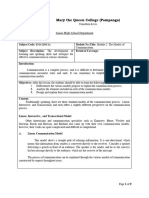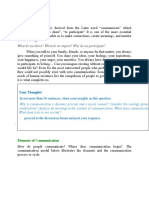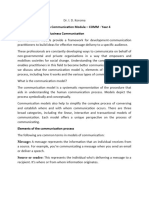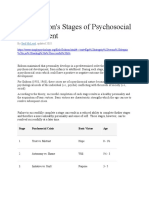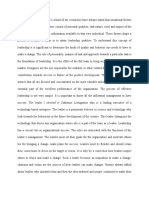0 ratings0% found this document useful (0 votes)
116 views5 Models of Communication
5 Models of Communication
Uploaded by
Anonymous HBcjucZnThis document discusses 5 models of communication:
1. Aristotle's model views communication as one-way, with the sender actively transmitting a message to a passive receiver.
2. Berlo's model (SMCR) examines the source, message, channel, and receiver of communication. It recognizes encoding and decoding between parties.
3. Shannon and Weaver's model sees communication originating from an information source, being transmitted through signals, and potentially changing meaning before reaching its destination.
4. Schramm's model emphasizes encoding and decoding as essential to effective communication, and that communication requires feedback from the receiver.
5. Frank Dance's helical model views communication as unfolding over time, both progress
Copyright:
© All Rights Reserved
Available Formats
Download as DOCX, PDF, TXT or read online from Scribd
5 Models of Communication
5 Models of Communication
Uploaded by
Anonymous HBcjucZn0 ratings0% found this document useful (0 votes)
116 views2 pagesThis document discusses 5 models of communication:
1. Aristotle's model views communication as one-way, with the sender actively transmitting a message to a passive receiver.
2. Berlo's model (SMCR) examines the source, message, channel, and receiver of communication. It recognizes encoding and decoding between parties.
3. Shannon and Weaver's model sees communication originating from an information source, being transmitted through signals, and potentially changing meaning before reaching its destination.
4. Schramm's model emphasizes encoding and decoding as essential to effective communication, and that communication requires feedback from the receiver.
5. Frank Dance's helical model views communication as unfolding over time, both progress
Original Description:
Copyright
© © All Rights Reserved
Available Formats
DOCX, PDF, TXT or read online from Scribd
Share this document
Did you find this document useful?
Is this content inappropriate?
This document discusses 5 models of communication:
1. Aristotle's model views communication as one-way, with the sender actively transmitting a message to a passive receiver.
2. Berlo's model (SMCR) examines the source, message, channel, and receiver of communication. It recognizes encoding and decoding between parties.
3. Shannon and Weaver's model sees communication originating from an information source, being transmitted through signals, and potentially changing meaning before reaching its destination.
4. Schramm's model emphasizes encoding and decoding as essential to effective communication, and that communication requires feedback from the receiver.
5. Frank Dance's helical model views communication as unfolding over time, both progress
Copyright:
© All Rights Reserved
Available Formats
Download as DOCX, PDF, TXT or read online from Scribd
Download as docx, pdf, or txt
0 ratings0% found this document useful (0 votes)
116 views2 pages5 Models of Communication
5 Models of Communication
Uploaded by
Anonymous HBcjucZnThis document discusses 5 models of communication:
1. Aristotle's model views communication as one-way, with the sender actively transmitting a message to a passive receiver.
2. Berlo's model (SMCR) examines the source, message, channel, and receiver of communication. It recognizes encoding and decoding between parties.
3. Shannon and Weaver's model sees communication originating from an information source, being transmitted through signals, and potentially changing meaning before reaching its destination.
4. Schramm's model emphasizes encoding and decoding as essential to effective communication, and that communication requires feedback from the receiver.
5. Frank Dance's helical model views communication as unfolding over time, both progress
Copyright:
© All Rights Reserved
Available Formats
Download as DOCX, PDF, TXT or read online from Scribd
Download as docx, pdf, or txt
You are on page 1of 2
Asadon, Margaux Christie P.
HRDM11FA1
5 Models of Communication
Aristotle Model of Communication
The Aristotle model of communication is the widely accepted and the most common model of communication where the
sender sends the information or a message to the receivers to influence them and make them respond and act accordingly. Aristotle
model of communication is the golden rule to excel in public speaking, seminars, lectures where the sender makes his point clear by
designing an impressive content, passing on the message to the second part and they simply respond accordingly. Here the sender is
the active member and the receiver is passive one.
Berlo’s Model of Communication
Berlo’s model of communication operates on the SMCR model. S – Source, The source in other words also called the sender
is the one from whom the thought originates. He is the one who transfers the information to the receiver after carefully putting his
thoughts into words. M – Message, When an individual converts his thoughts into words, a message is created. The process is also
called as Encoding. C – Channel, Channel - Channel actually refers to the medium how the information flows from the sender to the
receiver. R – Receiver, When the message reaches the receiver, he tries to understand what the listener actually wants to convey and
then responds accordingly. This is also called as decoding. According to the berlo’s model of communication, the speaker and the
listener must be on a common ground for smooth conversion which is sometimes not practical in the real scenario.
Shannon and Weaver Model of Communication
Shannon and weaver model simply proposes that a message actually originates from the person who gets the thought or has
the information. The sender is also called the Source of information or the Information Source. The information then gets transmitted
from the brain to the mouth and comes out as a signal which then reaches the recipient after joining hands with several noises and
other disturbances. The recipient then further passes on the message to its final destination or other minds of other individuals. Thus
even a simple message can get a different meaning after finally reaching its destination.
Schramm’s Model of Communication
Wilber Schramm proposed the model of communication in 1954. Encoding plays a very important role because it initiates the
process of communication by converting the thought into content. When the information reaches the recipient his prime responsibility
is to understand what the speaker intends to convey. Unless and until the second party is able to understand or decode the
information what the sender wants to communicate, the message is actually of no use. Thus encoding and decoding are two most
important factors of an effective communication without which information can never flow between two individuals. Schramm’s model
also revolves around the above principle. According to the Schramm’s model, coding and decoding are the two essential processes of
an effective communication. He also emphasizes that the communication is incomplete unless and until the sender receives a
feedback from the recipient.
Helical Model of Communication
The Helical Model of communication was proposed by Frank Dance in 1967 to throw some more light on communication
process. Dance thought of communication process similar to helix. A Helix is nothing but a smooth curve just like a spring which if
goes upwards also comes downwards. The Helical model of communication was designed by Frank Dance keeping the simple Helix
in mind. According to the Helical model as the process of communication moves forward it also comes back and is largely dependant
on the past behaviour of the individual. The model believes that communication process is just like a helix which moves forward as
well as comes backward and is dependent on the behaviour patterns of the past definitely with some modifications and changes.The
Helical model of communication understands communication in a broader perspective and considers almost all the activities of an
individual from day one to till date. It cumulates all the activities occurring in the complete span of an individual that affects the
process of communication, which in turn goes forward and also depends on the past activities.
REFERENCE:
https://www.managementstudyguide.com/aristotle-model-of-communication.htm
You might also like
- Personality DevelopmentDocument33 pagesPersonality Developmentprathibaadabala71% (38)
- Inc410 Movie ReviewDocument10 pagesInc410 Movie ReviewDhiya QistinaNo ratings yet
- Abnormal Child and Adolescent Psychology 8th Edition Test BankDocument13 pagesAbnormal Child and Adolescent Psychology 8th Edition Test BankgloriyaNo ratings yet
- Teaching Strategies For Nurse EducatorsDocument3 pagesTeaching Strategies For Nurse EducatorsNica Marie LumbaNo ratings yet
- Models of CommunicationDocument39 pagesModels of Communicationqwertyuiop100% (13)
- K To 12 Framework For KcwaDocument4 pagesK To 12 Framework For KcwaCarol Rombaoa SerdeniaNo ratings yet
- Building Effective Teams enDocument3 pagesBuilding Effective Teams enLeni ANo ratings yet
- Different Models of CommunicationDocument9 pagesDifferent Models of CommunicationBhosz Leo Lee100% (1)
- PC ReviewerDocument2 pagesPC ReviewerBernardNo ratings yet
- Communication ModelsDocument26 pagesCommunication ModelsWu XianNo ratings yet
- Understanding Human Communication 1Document16 pagesUnderstanding Human Communication 1ilantamizh RNo ratings yet
- Models of CommunicationDocument41 pagesModels of CommunicationJan ArnoldNo ratings yet
- 1st-Quarter-Key-Concepts-Oral-CommunicationDocument20 pages1st-Quarter-Key-Concepts-Oral-CommunicationbpaulmarcusNo ratings yet
- Module 1Document13 pagesModule 1Charize V. Teope 10-hawkNo ratings yet
- Communication Intro1Document5 pagesCommunication Intro1Carlo Jhan LolongNo ratings yet
- Oral CommunicationDocument21 pagesOral Communicationrowena.enorpeNo ratings yet
- Models of CommunicationDocument17 pagesModels of CommunicationMousumi KuilaNo ratings yet
- MODULE 1 Purposive CommunicationDocument12 pagesMODULE 1 Purposive CommunicationMarjorie BorlonganNo ratings yet
- Submitted by Lourdan Elaba Xi-Stem Einstein Submitted To Mrs. BongonDocument7 pagesSubmitted by Lourdan Elaba Xi-Stem Einstein Submitted To Mrs. BongonBhosz Leo LeeNo ratings yet
- Presentation TitleDocument29 pagesPresentation Titlemahnoor tahirNo ratings yet
- The Communication Model ShaiDocument9 pagesThe Communication Model ShaiShainna PanopioNo ratings yet
- P Model KomunikasiDocument41 pagesP Model KomunikasiI Wayan SutamaNo ratings yet
- Orlcom1 ReviewerDocument16 pagesOrlcom1 ReviewerAlyanna ManaloNo ratings yet
- Definition Elements and Models of CommunicationDocument23 pagesDefinition Elements and Models of CommunicationMorbid FreelanceNo ratings yet
- Communication Models Describe The Process of CommunicationDocument4 pagesCommunication Models Describe The Process of CommunicationMaria GraceNo ratings yet
- CGMartin OCModule2Document9 pagesCGMartin OCModule2Cloie Irish MartinNo ratings yet
- The Various Models of CommunicationDocument36 pagesThe Various Models of CommunicationArmie Salayog100% (1)
- Communication ModelsDocument3 pagesCommunication ModelsMary Yvonne AresNo ratings yet
- Models of Communication: Shannon and WeaverDocument9 pagesModels of Communication: Shannon and Weaverfannie gaspiNo ratings yet
- Lesson Proper: What Do We Share? What Do We Impart? Why Do We Participate?Document21 pagesLesson Proper: What Do We Share? What Do We Impart? Why Do We Participate?BeaNo ratings yet
- Lesson 4 - Communication ModelsDocument27 pagesLesson 4 - Communication ModelsAicha Ellen BalabaNo ratings yet
- Modelsofcommunicationhandout 160711061345 PDFDocument39 pagesModelsofcommunicationhandout 160711061345 PDFRicaNo ratings yet
- The Role of Models in Business CommunicationDocument6 pagesThe Role of Models in Business Communicationmanzjojo0No ratings yet
- COMMUNICATION MODELS Unit 3Document33 pagesCOMMUNICATION MODELS Unit 3Sanjani kumariNo ratings yet
- Oral Communication ResearchhhhhhhDocument8 pagesOral Communication ResearchhhhhhhRonie PadlanNo ratings yet
- Lesson 6 Classical Models of CommunicationDocument4 pagesLesson 6 Classical Models of Communicationnyam6130No ratings yet
- Self NotesDocument100 pagesSelf NotesPragya ChakshooNo ratings yet
- Communication TheoryDocument5 pagesCommunication TheoryJulie Ann GernaNo ratings yet
- Models of Communication: Communication Theory - M2 Assignment No: 01Document12 pagesModels of Communication: Communication Theory - M2 Assignment No: 01Zargham AliNo ratings yet
- Models of CommunicationDocument10 pagesModels of CommunicationNeil Tracy Garzon MalnegroNo ratings yet
- Lesson 1: Nature of Language and CommunicationDocument9 pagesLesson 1: Nature of Language and CommunicationJehada AbdukadilNo ratings yet
- Lesson 1: Nature of Language and CommunicationDocument9 pagesLesson 1: Nature of Language and CommunicationJehada AbdukadilNo ratings yet
- Prelim Exam Purposive Communication Ebit, Champagne-Rain T. Bsedfilipino (Asyn) 2ND SemDocument10 pagesPrelim Exam Purposive Communication Ebit, Champagne-Rain T. Bsedfilipino (Asyn) 2ND SemChampagne Rain EbitNo ratings yet
- Introduction To Mass CommunicationDocument23 pagesIntroduction To Mass CommunicationRimshaNo ratings yet
- Modelsofcommunication RascoDocument36 pagesModelsofcommunication Rascomervinrasco19No ratings yet
- Communication, Information or Content (E.g. A Message in Natural Language) Is Sent in Some FormDocument5 pagesCommunication, Information or Content (E.g. A Message in Natural Language) Is Sent in Some FormGian Paul JavierNo ratings yet
- Alexander The Great Linear Model of CommunicationDocument6 pagesAlexander The Great Linear Model of CommunicationCarl AndreaNo ratings yet
- Chapter 3 Organizational CommunicationDocument49 pagesChapter 3 Organizational CommunicationJose Marie AnoosNo ratings yet
- Lesson 3 Models of CommunicationDocument3 pagesLesson 3 Models of CommunicationEuwella GloriaNo ratings yet
- Eng111 Unit IDocument19 pagesEng111 Unit ILumactod EarthanNo ratings yet
- Oralcom Module 2 Week 2 Models of CommunicationDocument9 pagesOralcom Module 2 Week 2 Models of CommunicationCesarNo ratings yet
- Models of Communication. Linear Model of Communication (Shannon-Weaver Model)Document6 pagesModels of Communication. Linear Model of Communication (Shannon-Weaver Model)Максим МорозNo ratings yet
- Interactive English (Pre-Final Examination)Document14 pagesInteractive English (Pre-Final Examination)georgia mae lacsonNo ratings yet
- 1 2 MergedDocument8 pages1 2 MergedAira CorderoNo ratings yet
- PC Finals ReviewerDocument20 pagesPC Finals Reviewermarvinbania92No ratings yet
- 1Document4 pages1Samantha ClaireNo ratings yet
- Notes in Osgood-Schramm Communication ModelDocument10 pagesNotes in Osgood-Schramm Communication ModelIlonah Jean B. VivencioNo ratings yet
- Process of CommunicationDocument42 pagesProcess of CommunicationNelson Gail DagaasNo ratings yet
- 2 Communication ModelsDocument36 pages2 Communication ModelsKent DosejoNo ratings yet
- Lesson 2 Models of CommunicationDocument52 pagesLesson 2 Models of CommunicationMarvic ReyesNo ratings yet
- Media Information and LiteracyDocument38 pagesMedia Information and Literacyvankirbylucero123No ratings yet
- Models and Theories of CommunicationDocument11 pagesModels and Theories of CommunicationaringkinkingNo ratings yet
- What Are The Communication Models? Why Do You Think They Were Introduced? There Are A Total of 5 Communication ModelDocument2 pagesWhat Are The Communication Models? Why Do You Think They Were Introduced? There Are A Total of 5 Communication ModelGrace Pascual100% (1)
- Oral Communication - NotesDocument3 pagesOral Communication - NotesLetecia AcainNo ratings yet
- Nature and Elements of CommunicationDocument5 pagesNature and Elements of Communicationsamantha beredoNo ratings yet
- MARK301 Exam RevisionDocument5 pagesMARK301 Exam RevisionWilliam HodsonNo ratings yet
- Bullying in School: Problem, Causes and SolutionsDocument9 pagesBullying in School: Problem, Causes and SolutionsNathan YavNo ratings yet
- Vildozola - N2 - Deep DiveDocument1 pageVildozola - N2 - Deep DiveShekainah Jane VildozolaNo ratings yet
- Active Learning Copy Paste WikipediaDocument3 pagesActive Learning Copy Paste WikipediaKunavathi Rajamohon100% (1)
- Fme Coaching Session ChecklistDocument2 pagesFme Coaching Session ChecklistLATIFNo ratings yet
- Principle of MGTDocument34 pagesPrinciple of MGTKajal MakwanaNo ratings yet
- General Psychology Syllabus 1st Sem 2013-2014Document7 pagesGeneral Psychology Syllabus 1st Sem 2013-2014api-224281496No ratings yet
- Unit 9 AssignmentDocument7 pagesUnit 9 Assignmentapi-521054554No ratings yet
- Reality Therapy: Counseling With Choice TheoryDocument7 pagesReality Therapy: Counseling With Choice TheoryNAshiraNo ratings yet
- Effect of Motivation On Employees Work P PDFDocument16 pagesEffect of Motivation On Employees Work P PDFDana NNo ratings yet
- Maslows Hierarchy of Needs in The Business Setting PDFDocument4 pagesMaslows Hierarchy of Needs in The Business Setting PDFKim Taehyung0% (1)
- What Is Conflict?Document15 pagesWhat Is Conflict?DooNo ratings yet
- Man Leader Vs Woman LeaderDocument31 pagesMan Leader Vs Woman LeaderVera Rachel MagayasNo ratings yet
- What Is SOCIAL RELATIONSHIPDocument23 pagesWhat Is SOCIAL RELATIONSHIPJoyce Manalo100% (1)
- MotivationDocument25 pagesMotivationsarodemayankNo ratings yet
- Esl 111 112 115 Diagnostic Prompt Fa15Document3 pagesEsl 111 112 115 Diagnostic Prompt Fa15api-285624898No ratings yet
- Human Relation MovementDocument10 pagesHuman Relation MovementLiew Sam Tat100% (1)
- UGMP-An Analysis of The Reward System On Employee Motivation A Case Study of Carrefour - Abu Dhabi, UAEDocument48 pagesUGMP-An Analysis of The Reward System On Employee Motivation A Case Study of Carrefour - Abu Dhabi, UAEjanithNo ratings yet
- Least Preferred Coworker ScaleDocument3 pagesLeast Preferred Coworker ScalelemuelNo ratings yet
- Erik Erikson'S Stages of Psychosocial Development: Saul McleodDocument9 pagesErik Erikson'S Stages of Psychosocial Development: Saul McleodMario AngNo ratings yet
- Effective LeadershipDocument3 pagesEffective LeadershipSananda BhattacharyaNo ratings yet
- Second Language AcquisitionDocument3 pagesSecond Language Acquisitionapi-385686971No ratings yet
- HeirarchyDocument3 pagesHeirarchyMazikeen LilimNo ratings yet
- Self Directed LearningDocument28 pagesSelf Directed LearningDivya Punjwani100% (2)


























